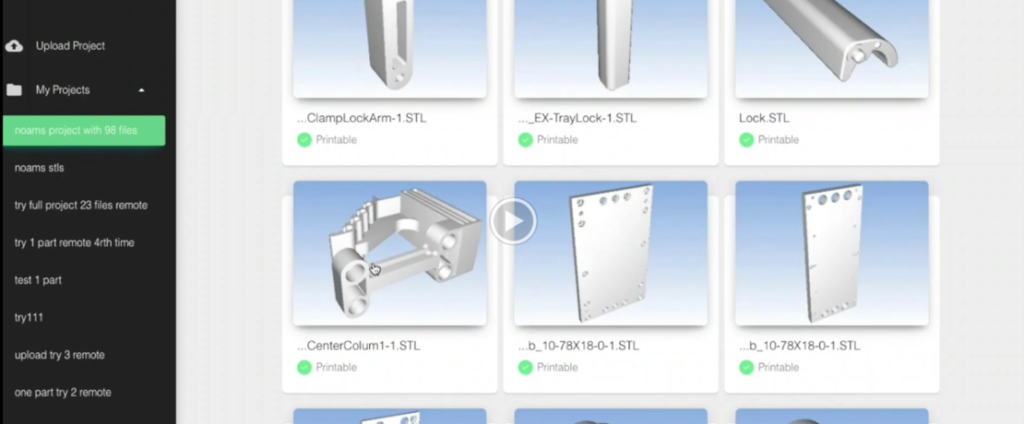Chemical giant and 3D printing materials company Evonik has introduced its first software for additive manufacturing (AM). The software is meant to reduce AM costs by helping users determine the proper 3D printing process depending on geometry, material and financial analysis of a part.
The technology behind the software was developed by Castor Technologies, an Israeli startup that Evonik Venture Capital invested in in October 2019. The software is framed as an auxiliary tool alongside CAD programs so that engineers can open existing CAD files, whether entire assemblies or a multitude of individual parts at once with the tool. The tool then performs an analysis of these parts and determines which are printable, how to make printable those that aren’t and the best material for printing them. It also estimates the cost and lead time and directs users to service bureaus that can print them.
The results are provided in the form of a report that includes the break-even point for AM as compared to traditional manufacturing processes. With this data, manufacturers are meant to be able to determine if and how 3D printing should be applied to the components they make.
While there are numerous methods for estimating the cost of printing a component using various AM services, a dedicated tool that determines how cost-effective using AM to fabricate a large number of parts compared to conventional methods does not yet exist on the market. Because additive is beginning to see widespread adoption and can introduce cost savings where appropriate, the tool has the potential to allow manufacturers to identify low-hanging fruit to introduce them to the technology before embarking on more involved additive projects. By giving potential users a deeper understanding of AM and its costs this could make AM much more of a viable option for many companies.
In one case study, Stanley Black and Decker used Castor’s technology to determine if any of its tooling should be produced via AM. One of the constraints was an eight-week-long lead time associated with having them made via traditional techniques. After uploading a number of tooling components, such as jigs and fixtures, Castor’s technology was able to determine high complexity, low volume parts that could be best suited for AM.
A wire lifter, for instance, was determined to be a good candidate for metal 3D printing, with an EOS M-290 system and maraging steel the system and material of choice. FIT America was selected as the service provider for the part. The software determined that the 3D printing cost for the tool would be $61 per part for 15 parts annually, compared to $120 per part using conventional manufacturing. This meant a nearly 50 percent cost reduction and the lead time was dropped from eight weeks to nine days.
“With the software, broader adoption of 3D printing at a commercial scale is now possible,” said Thomas Große-Puppendahl, head of the innovation growth field additive manufacturing at Evonik. “That will offer us better insights into customer needs and preferences in order to develop new “ready-to-use” materials.”
We don’t yet know exactly how much of Castor’s base platform is integrated into Evonik’s software; however, it is an interesting way for an additive materials manufacturer to expand to other products. In addition to its investment in Castor, Evonik provided its 20 years of additive materials expertise and ensured the accessibility of the tool to all industries. In turn, it’s possible that users might find Evonik’s polymer powders or filaments desirable for the production of their components.
Subscribe to Our Email Newsletter
Stay up-to-date on all the latest news from the 3D printing industry and receive information and offers from third party vendors.
You May Also Like
Profiling a Construction 3D Printing Pioneer: US Army Corps of Engineers’ Megan Kreiger
The world of construction 3D printing is still so new that the true experts can probably be counted on two hands. Among them is Megan Kreiger, Portfolio Manager of Additive...
US Army Corps of Engineers Taps Lincoln Electric & Eaton for Largest 3D Printed US Civil Works Part
The Soo Locks sit on the US-Canadian border, enabling maritime travel between Lake Superior and Lake Huron, from which ships can reach the rest of the Great Lakes. Crafts carrying...
Construction 3D Printing CEO Reflects on Being Female in Construction
Natalie Wadley, CEO of ChangeMaker3D, could hear the words of her daughter sitting next to her resounding in her head. “Mum, MUM, you’ve won!” Wadley had just won the prestigious...
1Print to Commercialize 3D Printed Coastal Resilience Solutions
1Print, a company that specializes in deploying additive construction (AC) for infrastructure projects, has entered an agreement with the University of Miami (UM) to accelerate commercialization of the SEAHIVE shoreline...






























